Comprehensive Analysis of Employment Laws in Sri Lanka
VerifiedAdded on 2020/10/23
|9
|2538
|492
Report
AI Summary
This report provides a detailed analysis of employment laws in Sri Lanka. It begins with an overview of dispute resolution methods, including arbitration, mediation, and negotiation, and the roles of industrial courts and labor tribunals. The report then examines women's employment rights under various statutes, focusing on maternity benefits and protections. It also delves into the prohibition of child employment, discussing constitutional provisions and relevant legislation. Furthermore, the report explores the rights and immunities granted under the Trade Unions Ordinance, including picketing, boycotts, and strikes. The report concludes with a summary of the key aspects of Sri Lankan employment law, providing a comprehensive understanding of the regulations governing employer-employee relations in the country.

Employment Laws
Paraphrase This Document
Need a fresh take? Get an instant paraphrase of this document with our AI Paraphraser
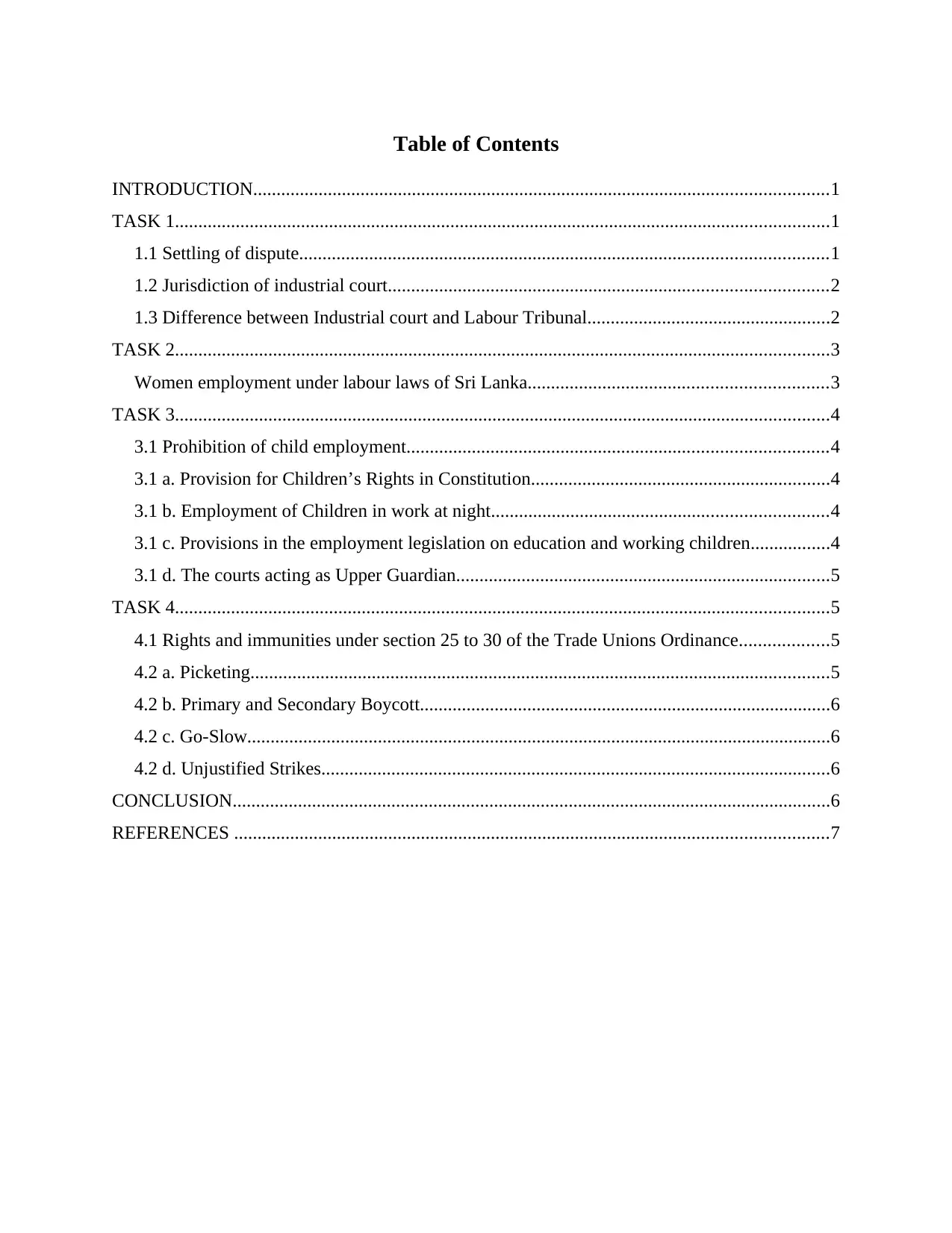
Table of Contents
INTRODUCTION...........................................................................................................................1
TASK 1............................................................................................................................................1
1.1 Settling of dispute.................................................................................................................1
1.2 Jurisdiction of industrial court..............................................................................................2
1.3 Difference between Industrial court and Labour Tribunal....................................................2
TASK 2............................................................................................................................................3
Women employment under labour laws of Sri Lanka................................................................3
TASK 3............................................................................................................................................4
3.1 Prohibition of child employment..........................................................................................4
3.1 a. Provision for Children’s Rights in Constitution................................................................4
3.1 b. Employment of Children in work at night........................................................................4
3.1 c. Provisions in the employment legislation on education and working children.................4
3.1 d. The courts acting as Upper Guardian................................................................................5
TASK 4............................................................................................................................................5
4.1 Rights and immunities under section 25 to 30 of the Trade Unions Ordinance...................5
4.2 a. Picketing............................................................................................................................5
4.2 b. Primary and Secondary Boycott........................................................................................6
4.2 c. Go-Slow.............................................................................................................................6
4.2 d. Unjustified Strikes.............................................................................................................6
CONCLUSION................................................................................................................................6
REFERENCES ...............................................................................................................................7
INTRODUCTION...........................................................................................................................1
TASK 1............................................................................................................................................1
1.1 Settling of dispute.................................................................................................................1
1.2 Jurisdiction of industrial court..............................................................................................2
1.3 Difference between Industrial court and Labour Tribunal....................................................2
TASK 2............................................................................................................................................3
Women employment under labour laws of Sri Lanka................................................................3
TASK 3............................................................................................................................................4
3.1 Prohibition of child employment..........................................................................................4
3.1 a. Provision for Children’s Rights in Constitution................................................................4
3.1 b. Employment of Children in work at night........................................................................4
3.1 c. Provisions in the employment legislation on education and working children.................4
3.1 d. The courts acting as Upper Guardian................................................................................5
TASK 4............................................................................................................................................5
4.1 Rights and immunities under section 25 to 30 of the Trade Unions Ordinance...................5
4.2 a. Picketing............................................................................................................................5
4.2 b. Primary and Secondary Boycott........................................................................................6
4.2 c. Go-Slow.............................................................................................................................6
4.2 d. Unjustified Strikes.............................................................................................................6
CONCLUSION................................................................................................................................6
REFERENCES ...............................................................................................................................7
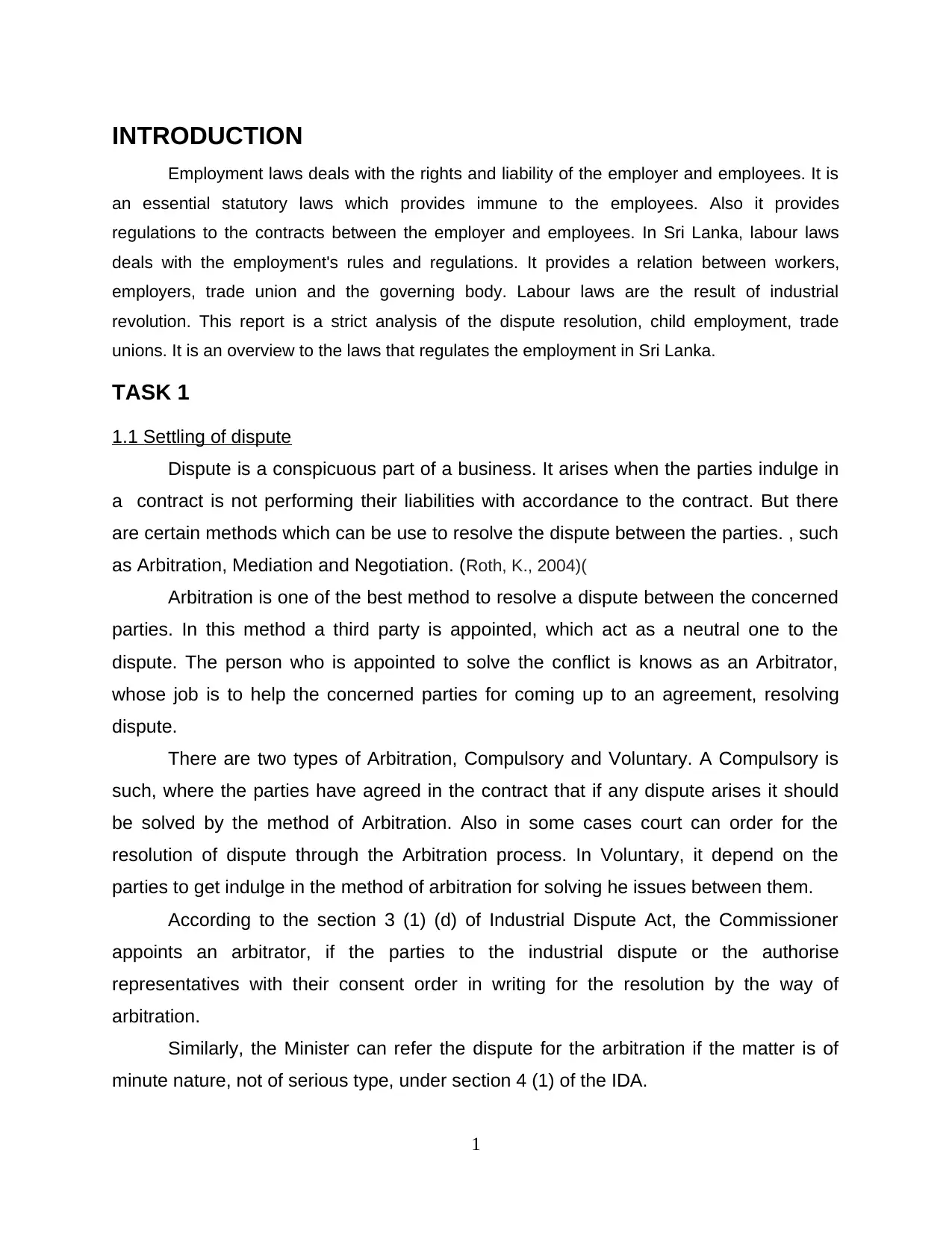
INTRODUCTION
Employment laws deals with the rights and liability of the employer and employees. It is
an essential statutory laws which provides immune to the employees. Also it provides
regulations to the contracts between the employer and employees. In Sri Lanka, labour laws
deals with the employment's rules and regulations. It provides a relation between workers,
employers, trade union and the governing body. Labour laws are the result of industrial
revolution. This report is a strict analysis of the dispute resolution, child employment, trade
unions. It is an overview to the laws that regulates the employment in Sri Lanka.
TASK 1
1.1 Settling of dispute
Dispute is a conspicuous part of a business. It arises when the parties indulge in
a contract is not performing their liabilities with accordance to the contract. But there
are certain methods which can be use to resolve the dispute between the parties. , such
as Arbitration, Mediation and Negotiation. (Roth, K., 2004)(
Arbitration is one of the best method to resolve a dispute between the concerned
parties. In this method a third party is appointed, which act as a neutral one to the
dispute. The person who is appointed to solve the conflict is knows as an Arbitrator,
whose job is to help the concerned parties for coming up to an agreement, resolving
dispute.
There are two types of Arbitration, Compulsory and Voluntary. A Compulsory is
such, where the parties have agreed in the contract that if any dispute arises it should
be solved by the method of Arbitration. Also in some cases court can order for the
resolution of dispute through the Arbitration process. In Voluntary, it depend on the
parties to get indulge in the method of arbitration for solving he issues between them.
According to the section 3 (1) (d) of Industrial Dispute Act, the Commissioner
appoints an arbitrator, if the parties to the industrial dispute or the authorise
representatives with their consent order in writing for the resolution by the way of
arbitration.
Similarly, the Minister can refer the dispute for the arbitration if the matter is of
minute nature, not of serious type, under section 4 (1) of the IDA.
1
Employment laws deals with the rights and liability of the employer and employees. It is
an essential statutory laws which provides immune to the employees. Also it provides
regulations to the contracts between the employer and employees. In Sri Lanka, labour laws
deals with the employment's rules and regulations. It provides a relation between workers,
employers, trade union and the governing body. Labour laws are the result of industrial
revolution. This report is a strict analysis of the dispute resolution, child employment, trade
unions. It is an overview to the laws that regulates the employment in Sri Lanka.
TASK 1
1.1 Settling of dispute
Dispute is a conspicuous part of a business. It arises when the parties indulge in
a contract is not performing their liabilities with accordance to the contract. But there
are certain methods which can be use to resolve the dispute between the parties. , such
as Arbitration, Mediation and Negotiation. (Roth, K., 2004)(
Arbitration is one of the best method to resolve a dispute between the concerned
parties. In this method a third party is appointed, which act as a neutral one to the
dispute. The person who is appointed to solve the conflict is knows as an Arbitrator,
whose job is to help the concerned parties for coming up to an agreement, resolving
dispute.
There are two types of Arbitration, Compulsory and Voluntary. A Compulsory is
such, where the parties have agreed in the contract that if any dispute arises it should
be solved by the method of Arbitration. Also in some cases court can order for the
resolution of dispute through the Arbitration process. In Voluntary, it depend on the
parties to get indulge in the method of arbitration for solving he issues between them.
According to the section 3 (1) (d) of Industrial Dispute Act, the Commissioner
appoints an arbitrator, if the parties to the industrial dispute or the authorise
representatives with their consent order in writing for the resolution by the way of
arbitration.
Similarly, the Minister can refer the dispute for the arbitration if the matter is of
minute nature, not of serious type, under section 4 (1) of the IDA.
1
⊘ This is a preview!⊘
Do you want full access?
Subscribe today to unlock all pages.

Trusted by 1+ million students worldwide
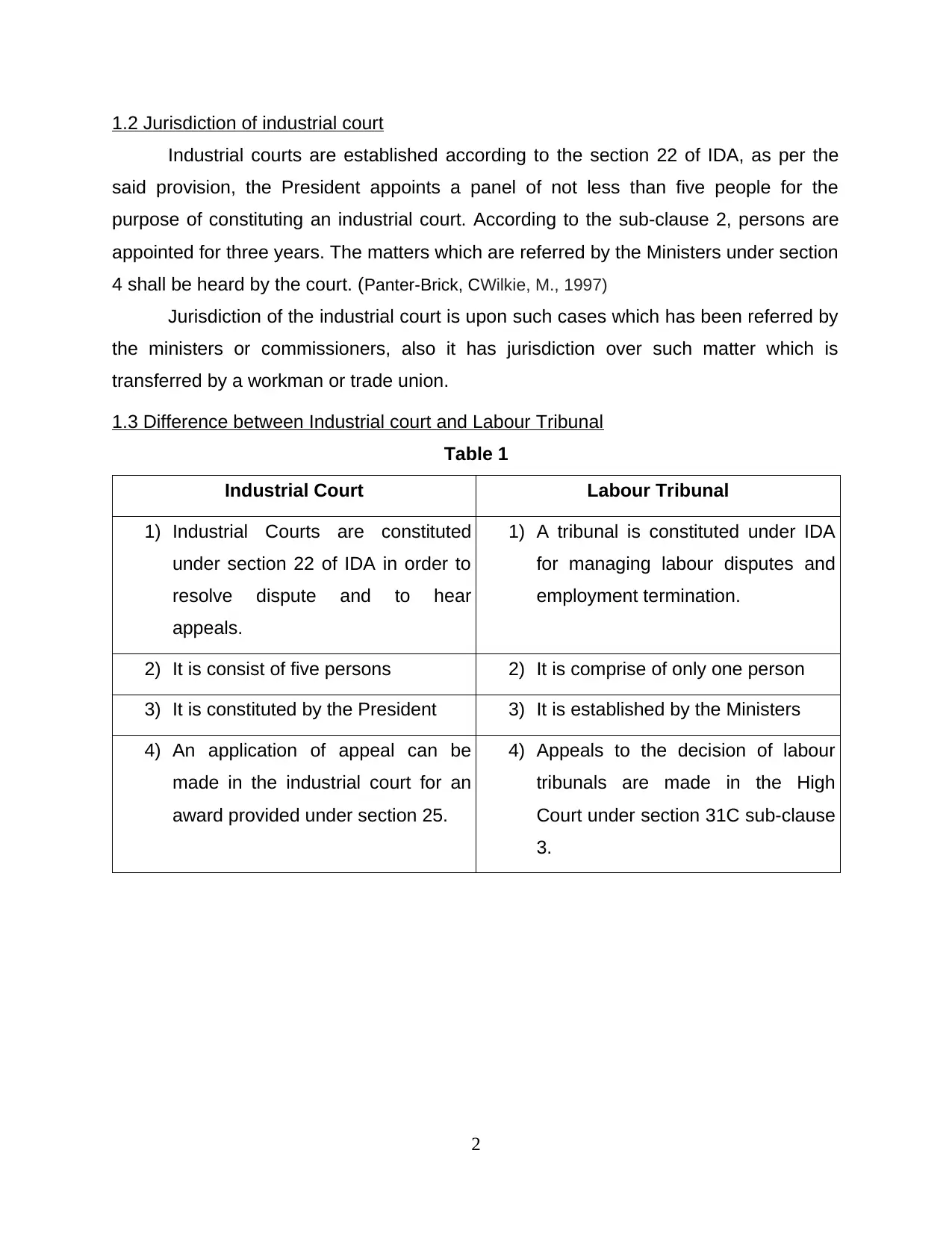
1.2 Jurisdiction of industrial court
Industrial courts are established according to the section 22 of IDA, as per the
said provision, the President appoints a panel of not less than five people for the
purpose of constituting an industrial court. According to the sub-clause 2, persons are
appointed for three years. The matters which are referred by the Ministers under section
4 shall be heard by the court. (Panter-Brick, CWilkie, M., 1997)
Jurisdiction of the industrial court is upon such cases which has been referred by
the ministers or commissioners, also it has jurisdiction over such matter which is
transferred by a workman or trade union.
1.3 Difference between Industrial court and Labour Tribunal
Table 1
Industrial Court Labour Tribunal
1) Industrial Courts are constituted
under section 22 of IDA in order to
resolve dispute and to hear
appeals.
1) A tribunal is constituted under IDA
for managing labour disputes and
employment termination.
2) It is consist of five persons 2) It is comprise of only one person
3) It is constituted by the President 3) It is established by the Ministers
4) An application of appeal can be
made in the industrial court for an
award provided under section 25.
4) Appeals to the decision of labour
tribunals are made in the High
Court under section 31C sub-clause
3.
2
Industrial courts are established according to the section 22 of IDA, as per the
said provision, the President appoints a panel of not less than five people for the
purpose of constituting an industrial court. According to the sub-clause 2, persons are
appointed for three years. The matters which are referred by the Ministers under section
4 shall be heard by the court. (Panter-Brick, CWilkie, M., 1997)
Jurisdiction of the industrial court is upon such cases which has been referred by
the ministers or commissioners, also it has jurisdiction over such matter which is
transferred by a workman or trade union.
1.3 Difference between Industrial court and Labour Tribunal
Table 1
Industrial Court Labour Tribunal
1) Industrial Courts are constituted
under section 22 of IDA in order to
resolve dispute and to hear
appeals.
1) A tribunal is constituted under IDA
for managing labour disputes and
employment termination.
2) It is consist of five persons 2) It is comprise of only one person
3) It is constituted by the President 3) It is established by the Ministers
4) An application of appeal can be
made in the industrial court for an
award provided under section 25.
4) Appeals to the decision of labour
tribunals are made in the High
Court under section 31C sub-clause
3.
2
Paraphrase This Document
Need a fresh take? Get an instant paraphrase of this document with our AI Paraphraser

TASK 2
Women employment under labour laws of Sri Lanka
There are certain relieves that has been provided to women employee under
various statutes. Such as maternity privileges under Maternity Benefits Ordinance 1939.
Also there are certain provisions that provides immune to a women employee.(Brysk, A.,
2013)
Apart from the Maternity ordinance, Shop and Office Employees Act 1954 also
provides some benefits to the women employee in Sri Lanka in the private sector.
According to section 18(A) of the Act maternity benefits are provided to every women
working in a business of shops and offices or such related to it. Also according to
section 12B a women employee is provided with two, one hour nursing period until the
child is one is year old but the period may reduced to half.(Hertzke, A.D., 2004)
Section 18 (D) (1) of Shop and Office Employment Act and 10 (B) (1) provides
immune to a women employee who is pregnant from working which may harm the
employee or her child in the period of last three months of pregnancy. Also a women
employee has been provided safe employment for 6 months, 3 months before the
pregnancy and 3 months after it.
A women employee is prohibited from getting into employment for first four week
after her confinement under section 2 of Maternity Ordinance. Also according to section
10 of the ordinance restraint any notice of termination of such women employee, similar
immunity has been provided in section 18F of the Shop and Office Employees Act.
Pay during the term of leave for pregnancy has been provided by certain
provisions of these statutes . In accordance with section 5 of the Maternity Ordinance, a
pregnant women employee is eligible for full payment during the period of their
pregnancy. Also sub-clause 3 of this section provides them alternative leave. Similar to
it, section 18C of the Shop and Office Act is provided with the full payment in the
course of pregnancy.(Gershoff, E.T. and Bitensky, S.H., 2007)
These were the certain immune that has been provided to the women employee
in Sri Lanka.
3
Women employment under labour laws of Sri Lanka
There are certain relieves that has been provided to women employee under
various statutes. Such as maternity privileges under Maternity Benefits Ordinance 1939.
Also there are certain provisions that provides immune to a women employee.(Brysk, A.,
2013)
Apart from the Maternity ordinance, Shop and Office Employees Act 1954 also
provides some benefits to the women employee in Sri Lanka in the private sector.
According to section 18(A) of the Act maternity benefits are provided to every women
working in a business of shops and offices or such related to it. Also according to
section 12B a women employee is provided with two, one hour nursing period until the
child is one is year old but the period may reduced to half.(Hertzke, A.D., 2004)
Section 18 (D) (1) of Shop and Office Employment Act and 10 (B) (1) provides
immune to a women employee who is pregnant from working which may harm the
employee or her child in the period of last three months of pregnancy. Also a women
employee has been provided safe employment for 6 months, 3 months before the
pregnancy and 3 months after it.
A women employee is prohibited from getting into employment for first four week
after her confinement under section 2 of Maternity Ordinance. Also according to section
10 of the ordinance restraint any notice of termination of such women employee, similar
immunity has been provided in section 18F of the Shop and Office Employees Act.
Pay during the term of leave for pregnancy has been provided by certain
provisions of these statutes . In accordance with section 5 of the Maternity Ordinance, a
pregnant women employee is eligible for full payment during the period of their
pregnancy. Also sub-clause 3 of this section provides them alternative leave. Similar to
it, section 18C of the Shop and Office Act is provided with the full payment in the
course of pregnancy.(Gershoff, E.T. and Bitensky, S.H., 2007)
These were the certain immune that has been provided to the women employee
in Sri Lanka.
3
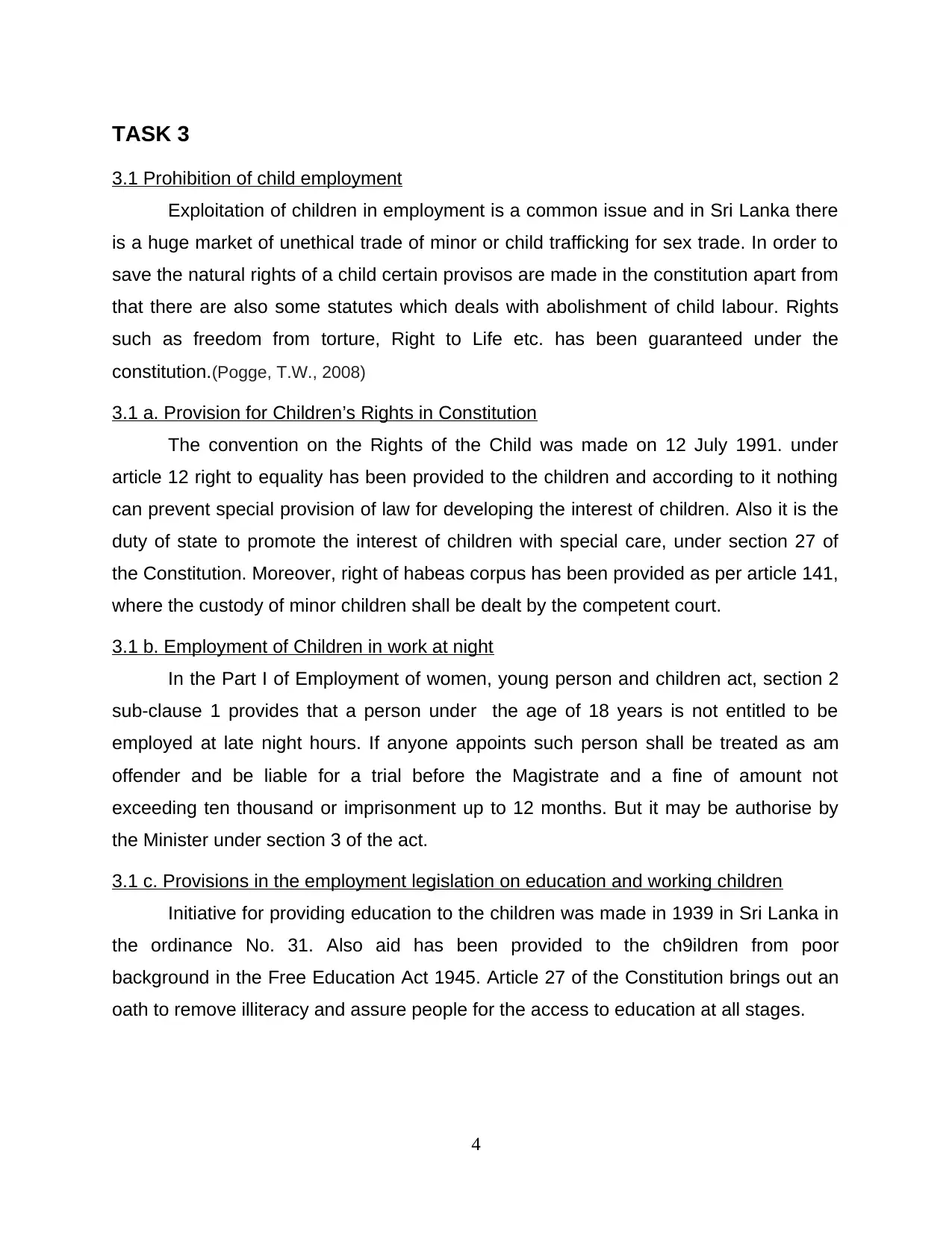
TASK 3
3.1 Prohibition of child employment
Exploitation of children in employment is a common issue and in Sri Lanka there
is a huge market of unethical trade of minor or child trafficking for sex trade. In order to
save the natural rights of a child certain provisos are made in the constitution apart from
that there are also some statutes which deals with abolishment of child labour. Rights
such as freedom from torture, Right to Life etc. has been guaranteed under the
constitution.(Pogge, T.W., 2008)
3.1 a. Provision for Children’s Rights in Constitution
The convention on the Rights of the Child was made on 12 July 1991. under
article 12 right to equality has been provided to the children and according to it nothing
can prevent special provision of law for developing the interest of children. Also it is the
duty of state to promote the interest of children with special care, under section 27 of
the Constitution. Moreover, right of habeas corpus has been provided as per article 141,
where the custody of minor children shall be dealt by the competent court.
3.1 b. Employment of Children in work at night
In the Part I of Employment of women, young person and children act, section 2
sub-clause 1 provides that a person under the age of 18 years is not entitled to be
employed at late night hours. If anyone appoints such person shall be treated as am
offender and be liable for a trial before the Magistrate and a fine of amount not
exceeding ten thousand or imprisonment up to 12 months. But it may be authorise by
the Minister under section 3 of the act.
3.1 c. Provisions in the employment legislation on education and working children
Initiative for providing education to the children was made in 1939 in Sri Lanka in
the ordinance No. 31. Also aid has been provided to the ch9ildren from poor
background in the Free Education Act 1945. Article 27 of the Constitution brings out an
oath to remove illiteracy and assure people for the access to education at all stages.
4
3.1 Prohibition of child employment
Exploitation of children in employment is a common issue and in Sri Lanka there
is a huge market of unethical trade of minor or child trafficking for sex trade. In order to
save the natural rights of a child certain provisos are made in the constitution apart from
that there are also some statutes which deals with abolishment of child labour. Rights
such as freedom from torture, Right to Life etc. has been guaranteed under the
constitution.(Pogge, T.W., 2008)
3.1 a. Provision for Children’s Rights in Constitution
The convention on the Rights of the Child was made on 12 July 1991. under
article 12 right to equality has been provided to the children and according to it nothing
can prevent special provision of law for developing the interest of children. Also it is the
duty of state to promote the interest of children with special care, under section 27 of
the Constitution. Moreover, right of habeas corpus has been provided as per article 141,
where the custody of minor children shall be dealt by the competent court.
3.1 b. Employment of Children in work at night
In the Part I of Employment of women, young person and children act, section 2
sub-clause 1 provides that a person under the age of 18 years is not entitled to be
employed at late night hours. If anyone appoints such person shall be treated as am
offender and be liable for a trial before the Magistrate and a fine of amount not
exceeding ten thousand or imprisonment up to 12 months. But it may be authorise by
the Minister under section 3 of the act.
3.1 c. Provisions in the employment legislation on education and working children
Initiative for providing education to the children was made in 1939 in Sri Lanka in
the ordinance No. 31. Also aid has been provided to the ch9ildren from poor
background in the Free Education Act 1945. Article 27 of the Constitution brings out an
oath to remove illiteracy and assure people for the access to education at all stages.
4
⊘ This is a preview!⊘
Do you want full access?
Subscribe today to unlock all pages.

Trusted by 1+ million students worldwide
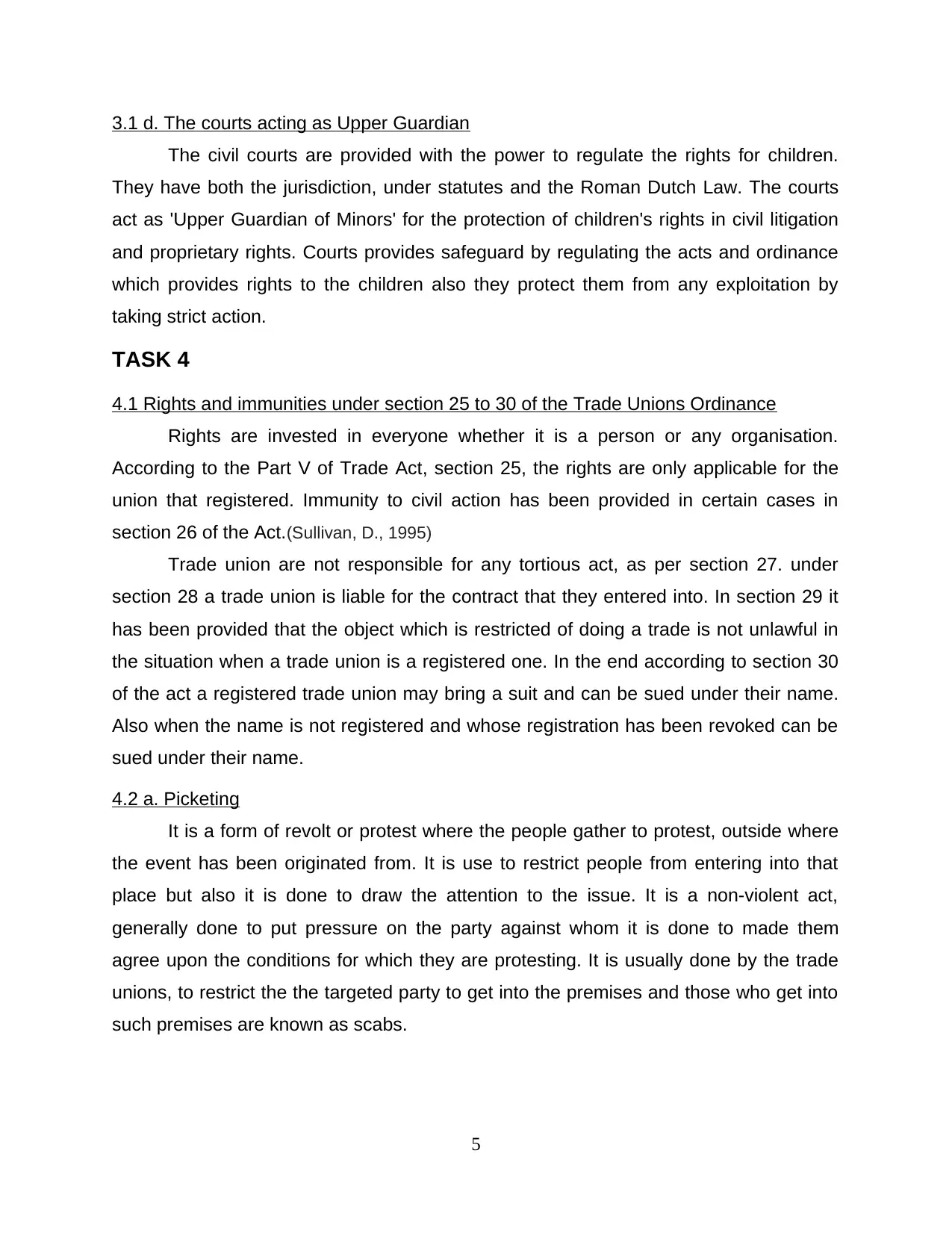
3.1 d. The courts acting as Upper Guardian
The civil courts are provided with the power to regulate the rights for children.
They have both the jurisdiction, under statutes and the Roman Dutch Law. The courts
act as 'Upper Guardian of Minors' for the protection of children's rights in civil litigation
and proprietary rights. Courts provides safeguard by regulating the acts and ordinance
which provides rights to the children also they protect them from any exploitation by
taking strict action.
TASK 4
4.1 Rights and immunities under section 25 to 30 of the Trade Unions Ordinance
Rights are invested in everyone whether it is a person or any organisation.
According to the Part V of Trade Act, section 25, the rights are only applicable for the
union that registered. Immunity to civil action has been provided in certain cases in
section 26 of the Act.(Sullivan, D., 1995)
Trade union are not responsible for any tortious act, as per section 27. under
section 28 a trade union is liable for the contract that they entered into. In section 29 it
has been provided that the object which is restricted of doing a trade is not unlawful in
the situation when a trade union is a registered one. In the end according to section 30
of the act a registered trade union may bring a suit and can be sued under their name.
Also when the name is not registered and whose registration has been revoked can be
sued under their name.
4.2 a. Picketing
It is a form of revolt or protest where the people gather to protest, outside where
the event has been originated from. It is use to restrict people from entering into that
place but also it is done to draw the attention to the issue. It is a non-violent act,
generally done to put pressure on the party against whom it is done to made them
agree upon the conditions for which they are protesting. It is usually done by the trade
unions, to restrict the the targeted party to get into the premises and those who get into
such premises are known as scabs.
5
The civil courts are provided with the power to regulate the rights for children.
They have both the jurisdiction, under statutes and the Roman Dutch Law. The courts
act as 'Upper Guardian of Minors' for the protection of children's rights in civil litigation
and proprietary rights. Courts provides safeguard by regulating the acts and ordinance
which provides rights to the children also they protect them from any exploitation by
taking strict action.
TASK 4
4.1 Rights and immunities under section 25 to 30 of the Trade Unions Ordinance
Rights are invested in everyone whether it is a person or any organisation.
According to the Part V of Trade Act, section 25, the rights are only applicable for the
union that registered. Immunity to civil action has been provided in certain cases in
section 26 of the Act.(Sullivan, D., 1995)
Trade union are not responsible for any tortious act, as per section 27. under
section 28 a trade union is liable for the contract that they entered into. In section 29 it
has been provided that the object which is restricted of doing a trade is not unlawful in
the situation when a trade union is a registered one. In the end according to section 30
of the act a registered trade union may bring a suit and can be sued under their name.
Also when the name is not registered and whose registration has been revoked can be
sued under their name.
4.2 a. Picketing
It is a form of revolt or protest where the people gather to protest, outside where
the event has been originated from. It is use to restrict people from entering into that
place but also it is done to draw the attention to the issue. It is a non-violent act,
generally done to put pressure on the party against whom it is done to made them
agree upon the conditions for which they are protesting. It is usually done by the trade
unions, to restrict the the targeted party to get into the premises and those who get into
such premises are known as scabs.
5
Paraphrase This Document
Need a fresh take? Get an instant paraphrase of this document with our AI Paraphraser
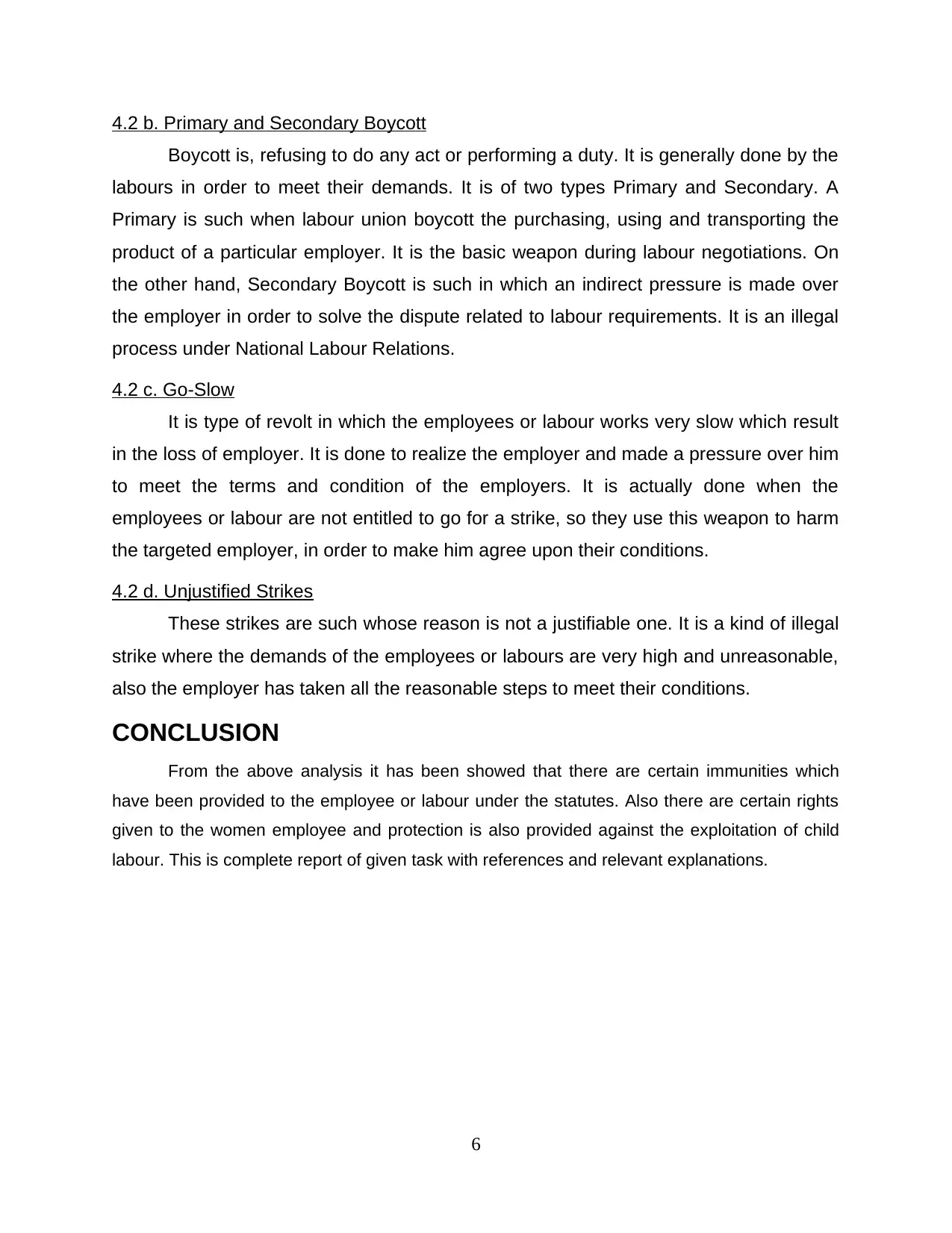
4.2 b. Primary and Secondary Boycott
Boycott is, refusing to do any act or performing a duty. It is generally done by the
labours in order to meet their demands. It is of two types Primary and Secondary. A
Primary is such when labour union boycott the purchasing, using and transporting the
product of a particular employer. It is the basic weapon during labour negotiations. On
the other hand, Secondary Boycott is such in which an indirect pressure is made over
the employer in order to solve the dispute related to labour requirements. It is an illegal
process under National Labour Relations.
4.2 c. Go-Slow
It is type of revolt in which the employees or labour works very slow which result
in the loss of employer. It is done to realize the employer and made a pressure over him
to meet the terms and condition of the employers. It is actually done when the
employees or labour are not entitled to go for a strike, so they use this weapon to harm
the targeted employer, in order to make him agree upon their conditions.
4.2 d. Unjustified Strikes
These strikes are such whose reason is not a justifiable one. It is a kind of illegal
strike where the demands of the employees or labours are very high and unreasonable,
also the employer has taken all the reasonable steps to meet their conditions.
CONCLUSION
From the above analysis it has been showed that there are certain immunities which
have been provided to the employee or labour under the statutes. Also there are certain rights
given to the women employee and protection is also provided against the exploitation of child
labour. This is complete report of given task with references and relevant explanations.
6
Boycott is, refusing to do any act or performing a duty. It is generally done by the
labours in order to meet their demands. It is of two types Primary and Secondary. A
Primary is such when labour union boycott the purchasing, using and transporting the
product of a particular employer. It is the basic weapon during labour negotiations. On
the other hand, Secondary Boycott is such in which an indirect pressure is made over
the employer in order to solve the dispute related to labour requirements. It is an illegal
process under National Labour Relations.
4.2 c. Go-Slow
It is type of revolt in which the employees or labour works very slow which result
in the loss of employer. It is done to realize the employer and made a pressure over him
to meet the terms and condition of the employers. It is actually done when the
employees or labour are not entitled to go for a strike, so they use this weapon to harm
the targeted employer, in order to make him agree upon their conditions.
4.2 d. Unjustified Strikes
These strikes are such whose reason is not a justifiable one. It is a kind of illegal
strike where the demands of the employees or labours are very high and unreasonable,
also the employer has taken all the reasonable steps to meet their conditions.
CONCLUSION
From the above analysis it has been showed that there are certain immunities which
have been provided to the employee or labour under the statutes. Also there are certain rights
given to the women employee and protection is also provided against the exploitation of child
labour. This is complete report of given task with references and relevant explanations.
6

REFERENCES
Books and Journals
Roth, K., 2004. Defending economic, social and cultural rights: Practical issues faced by an international
human rights organization. Human Rights Quarterly, 26(1), pp.63-73.
Panter-Brick, C., 2002. Street children, human rights, and public health: A critique and future
directions. Annual review of anthropology, 31(1), pp.147-171.
Wilkie, M., 1997. Bringing them home: Report of the national inquiry into the separation of Aboriginal and
Torres Strait Islander children from their families. Human Rights and Equal Opportunity Commission.
Brysk, A., 2013. The politics of human rights in Argentina.
Hertzke, A.D., 2004. Freeing God's children: The unlikely alliance for global human rights. Rowman &
Littlefield.
Gershoff, E.T. and Bitensky, S.H., 2007. The case against corporal punishment of children: Converging
evidence from social science research and international human rights law and implications for US public
policy. Psychology, Public Policy, and Law, 13(4), p.231.
Pogge, T.W., 2008. World poverty and human rights. Polity.
Sullivan, D., 1995. The public/private distinction in international human rights law. Women’s Rights,
Human Rights: International Feminist Perspectives, pp.126-134.
Cook, R.J., 1993. Women's international human rights law: the way forward. Hum. Rts. Q., 15, p.230.
7
Books and Journals
Roth, K., 2004. Defending economic, social and cultural rights: Practical issues faced by an international
human rights organization. Human Rights Quarterly, 26(1), pp.63-73.
Panter-Brick, C., 2002. Street children, human rights, and public health: A critique and future
directions. Annual review of anthropology, 31(1), pp.147-171.
Wilkie, M., 1997. Bringing them home: Report of the national inquiry into the separation of Aboriginal and
Torres Strait Islander children from their families. Human Rights and Equal Opportunity Commission.
Brysk, A., 2013. The politics of human rights in Argentina.
Hertzke, A.D., 2004. Freeing God's children: The unlikely alliance for global human rights. Rowman &
Littlefield.
Gershoff, E.T. and Bitensky, S.H., 2007. The case against corporal punishment of children: Converging
evidence from social science research and international human rights law and implications for US public
policy. Psychology, Public Policy, and Law, 13(4), p.231.
Pogge, T.W., 2008. World poverty and human rights. Polity.
Sullivan, D., 1995. The public/private distinction in international human rights law. Women’s Rights,
Human Rights: International Feminist Perspectives, pp.126-134.
Cook, R.J., 1993. Women's international human rights law: the way forward. Hum. Rts. Q., 15, p.230.
7
⊘ This is a preview!⊘
Do you want full access?
Subscribe today to unlock all pages.

Trusted by 1+ million students worldwide
1 out of 9
Related Documents
Your All-in-One AI-Powered Toolkit for Academic Success.
+13062052269
info@desklib.com
Available 24*7 on WhatsApp / Email
![[object Object]](/_next/static/media/star-bottom.7253800d.svg)
Unlock your academic potential
Copyright © 2020–2025 A2Z Services. All Rights Reserved. Developed and managed by ZUCOL.





